Posted by McElroy Metal ● Jul 14, 2022 9:41 AM
Are Metal Roofs Hurricane Proof?
While it is impossible to call any roof hurricane-proof, a properly designed metal roofing system can be capable of handling wind speeds higher than what hurricane-prone regions typically experience.

Yet, in the aftermath of a hurricane’s landfall, it is not uncommon to see photographs that show metal roofing panels wrapped around a tree or buildings missing all or parts of their metal roof.
While these images make for sensational media views, they create a skewed perception about metal roofing’s performance in high wind events.
While hurricane-proof might be a stretch, it isn’t a stretch to say that metal roofing stands up better to the wrath of mother nature than other roofing choices.
When properly engineered and installed, metal roofing continues to garner more and more attention for its outstanding performance in post-hurricane analysis.
In this article, we want to look at a few top threats to metal roofing, some key design factors, partner selection tips, insurance discounts, and after storm clean-up.
Top Hurricane Threats to Metal Roofing
While crazy things occur when a hurricane makes landfall, the majority of roofing failures come back to one of these six issues:
- Lack of proper engineering
- Faulty installation
- Underperforming components like doors and windows
- Panel uplift or tear-off due to excessive wind speeds.
- Water infiltration due to extreme wind speeds and wind-driven rain
- Panel damage caused by flying debris.
Let’s examine each of these a bit further
Lack of Proper Engineering
An old adage says the best defense is a good offense. That statement certainly applies in any discussion of metal roofing and hurricane preparedness.
While local building codes typically mandate performance expectations (Miami Dade, for example), it’s always best to take things one step further and consult an engineer to discuss your project specifics and review relevant product data. It may even be prudent to request the engineer create signed project-specific calculations.
Yes, you’ll likely spend a few thousand dollars on engineering fees. Still, if it helps you better “weather the storm,” most would agree that it’s money well spent since lack of proper engineering is one of the most common reasons for metal roof failure in hurricane events.
Faulty Installation
Installation errors represent another major cause of hurricane-related metal roof failures. In some cases, the errors may be intentional and, in others, an oversight. Clip spacing is an excellent example because it directly affects panel performance for wind and uplift values.
While an engineer might properly design a standing seam system in Southern Florida with clips at 1’6” on-center, an installer might install them at 3’0” on-center.
Regardless of the reasons, placing clips too far apart, using incorrect fastener size, and placing the first fastener too far up from the eave or down from the ridge represent common problems that cause devastating roof failures, especially during hurricane events.
Underperforming Components
A metal roof system can be properly engineered and installed for high winds but fail if an underperforming door or window blows out, creating upward pressures in the home.
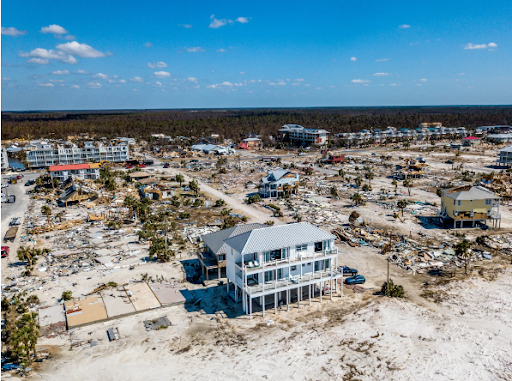 Photo courtesy of The New York Times
Photo courtesy of The New York Times
The New York Times highlighted a Mexico Beach, FL, house that withstood the damaging effects of Hurricane Michael in October 2018. This home suffered minimal damage while those surrounding it experienced devastation. How did this home perform so well? Engineered building components, designed to withstand hurricane-force winds, were used for the entire structure.
Metal Roof Uplift/Tear-Off
Properly designed and installed metal roofing often remains attached to the structure and, barring physical damage from flying debris, performs without leaks once the storm subsides.
A metal roof's overall performance depends on many variables that affect uplift pressures and wind speed.
The height of the building, shape, roof pitch, width of the building, and topography all affect the amount of force that a structure experiences during a hurricane.
Given that, it’s challenging to broadly state a specific system will perform well in all situations. That’s why we recommend working with a licensed engineer to determine the performance you can expect.
But to indicate the durability metal roofing offers, our Maxima or 238T panel systems can safely withstand wind speeds over 200 mph in many conditions.
Wind-Driven Rain
Testing for metal roof systems ensures they remain watertight up to and including hurricane-force winds.
However, it’s extremely critical that installation details be followed to the letter to ensure resistance to wind-driven rain.
Panel Damage Caused by Hail/Debris
Panel damage caused by flying debris is another common culprit for hurricane-related metal roofing damage.
In many cases, metal panels experience aesthetic damage, but the roofing system remains weather tight.
The two photos below, taken after Hurricane Harvey, tell a great story.
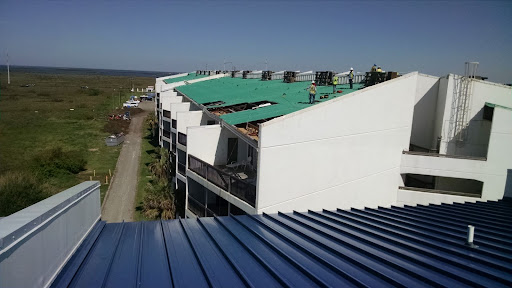
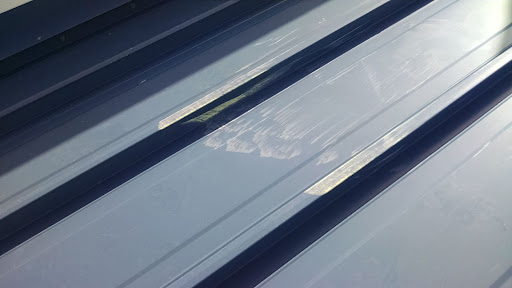
As you can see, some of the green roof panels blew off during the storm. The blue roof panels on the roof at a nearby property remained intact; however, approximately 20% of the blue panels required replacement for cosmetic damage (shown in the second image) caused by the green roof panels when they became airborne.
While it’s unfortunate that the blue panels required any replacement, it’s important to note that since the damage was cosmetic only, the owner could complete repairs at their convenience instead of the typical post-hurricane frenzy.
Key Design Factors
- The spacing and size of the sub-structural framing or decking for panel attachment are critical to performance. For example, open framing purlins spaced more closely together will have better panel performance than those spaced farther apart. Similarly, thicker metal or wood decking will perform better than similar but thinner materials.
- The panel attachment method (face fastened or clips) and the frequency of the attachment represent essential elements. For example, installing clips at 1’ on center instead of 2’ on center will significantly improve the panel's reaction to extreme wind events. Similarly, exposed fastener panel systems perform better in uplift conditions if the fasteners are placed at 20” on center instead of 30” on center.
- While total roof failures occur, it’s much more likely that only a portion of the roof panels will require repair. Consequently, symmetrical panel styles (like our 138T & 238T) should be considered for projects in hurricane-prone areas to facilitate single panel replacement. In contrast, panel repairs on asymmetrical systems (like our Maxima) often require removing undamaged panels simply to reach the damaged roof section.
- Panel styles also impact performance. Panels that engage by simply snapping together are some of the poorest performers in hurricane events. The extreme uplift pressures can cause the panels to simply unsnap from each other. Since face fastened panels attach directly to the roof deck or purlins, exposed fastener panels can perform well in high wind events. Mechanically seamed panels often offer the best wind uplift performance making them a favored choice in hurricane-prone areas.
- Panel width and gauge choices also carry performance implications. As a general rule, narrower panels offer greater resistance to wind uplift. Additionally, heavier gauge panels tend to perform better than lighter gauge panels.
- It’s important to design all major components properly. During high wind conditions, a building is only as strong as the weakest building component. A metal roof may also fail if doors, windows, or walls fail.
Choose Partners Wisely
Proper product selection is critical in hurricane-prone areas; however, it’s also essential to properly vet and select the right partners.
Engineers, Manufacturers, and installers all represent crucial functions in your project, and it’s vital to do your due diligence before assembling your project team.
Engineers
 Consult with local engineers that specialize in building and construction. Ask questions to confirm their experience with metal roofing and local building codes.
Consult with local engineers that specialize in building and construction. Ask questions to confirm their experience with metal roofing and local building codes.
Once you’ve selected an engineer, have them design the entire roofing assembly, including the roof deck material and thickness, roof panel style and gauge, and clip/fastener spacing.
Taking this step (and the additional cost) ensures the best chance for a predictable result should a hurricane impact your building.
Manufacturers
Work with a metal roofing manufacturer that has invested in the technology to complete in-house testing (like McElroy Metal) or uses third-party product testing to support their published load tables.
Classification and testing from agencies like UL and FM signify manufacturer commitment to engineering and safety.
If you’re trying to avoid the cost of hiring an engineer, at the very least, choose a metal roofing manufacturer with the ability to engineer their roofing systems to your local building code, which normally considers hurricane wind speeds.
Installers
 Installer selection is also critical. Even the best roof will fail to perform as expected when poorly installed. The MRA (Metal Roofing Alliance) has issued a warning in the wake of the recent hurricanes alerting consumers to the possibility of both material and installation quality concerns.
Installer selection is also critical. Even the best roof will fail to perform as expected when poorly installed. The MRA (Metal Roofing Alliance) has issued a warning in the wake of the recent hurricanes alerting consumers to the possibility of both material and installation quality concerns.
Renee Ramey, MRA Executive Director, tells consumers to “Beware of inferior material from unknown sources that some unscrupulous installers try to pass off at a discount. A good quality metal roof is made to stand the test of time and designed to offer outstanding protection.
It should have verifiable warranties, superior coatings, proper gauge and thickness for residential use, and be sourced from reputable manufacturers. Contractors also should warranty their work and be able to prove their experience and knowledge.”
In their warning to consumers, the MRA suggests some questions consumers should ask before starting a new metal roofing project that includes things like:
- Where is the roof manufactured?
- What warranties are available?
- Are your contractors members of well-known trade organizations?
These questions and suggestions can help guide consumers toward reputable, safe contractors and materials. You can find the full MRA warning and guidelines here.
Insurance Discounts and After Storm Clean Up
Some insurance providers offer discounts for homes with metal roofs for homeowners in hurricane-prone areas. While not guaranteed, the discounts offered can help reduce the cost difference between metal roofing and shingles.
For instance, State Farm states that they offer an insurance discount for qualifying metal roofs.
Consequently, when comparing different roof material types and costs, it’s important to contact your insurance provider and inquire about metal roof discounts.
After-storm repairs should be another consideration in your roofing selection. As discussed above, metal roofs represent an excellent choice in hurricane-prone areas due to their long-lasting, durable, and resistance to damage from high-speed winds.
This improved performance means there is a good chance you won’t face emergency repairs after the storm. While no roof is hurricane or windproof, selecting a metal roof means you might be able to skip the frenzy of trying to find a contractor (not to mention price gouging) in the days after the storm.
It also means there’s a good chance you’ll miss the hassle of roof leaks and insurance claims.
In closing, while no roof is genuinely hurricane-proof, metal offers distinct advantages to those in storm-prone areas.
Are you interested in learning more? Contact us to discuss the possibilities of using metal!
Be sure to check out our Residential Metal Roofs FAQ.
Learn everything you need to know about Residential Metal Roofing. Check out our metal roofing resources for inspiration and answers to your questions.
About McElroy Metal
Since 1963, McElroy Metal has served the construction industry with quality products and excellent customer service. The employee-owned components manufacturer is headquartered in Bossier City, La., and has 14 manufacturing facilities across the United States. Quality, service and performance have been the cornerstone of McElroy Metal’s business philosophy and have contributed to the success of the company through the years. As a preferred service provider, these values will continue to be at the forefront of McElroy Metal’s model along with a strong focus on the customer.
Topics: Education, Metal Roofing, Standing Seam Systems, FAQ, Residential, Maxima, 138T and 238T
Comments on this article:
Scroll down to the bottom to submit a comment and join the conversation. Need help or have a question? Please contact us. Looking for a distributor or contractor? Please click here to get started.


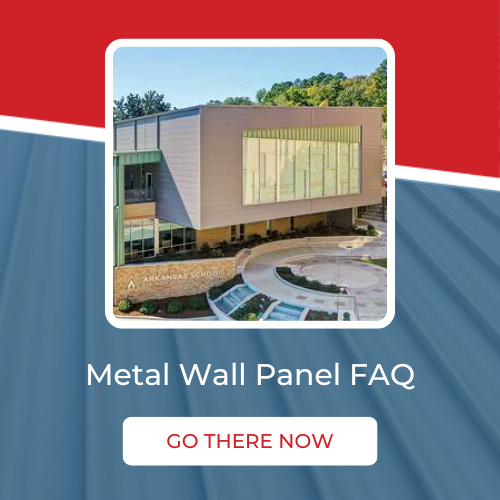


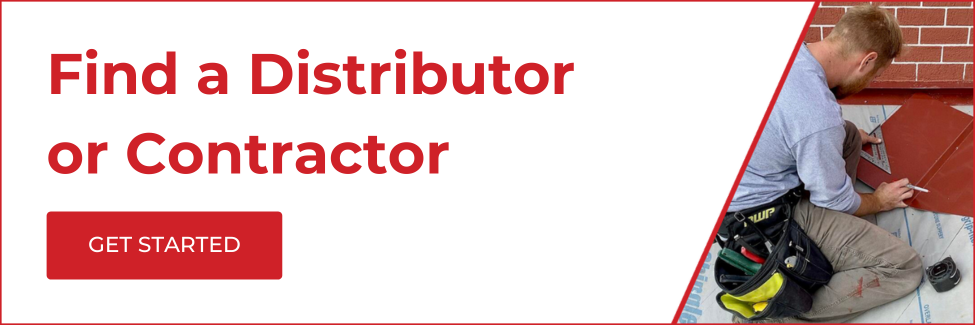


%20(002).png)